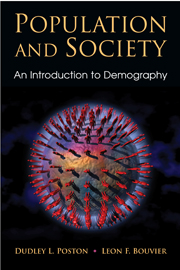Book contents
- Frontmatter
- Contents
- Preface
- Introduction
- 1 “We Are All Population Actors”: An Introduction to Demography
- 2 The Sources of Demographic Information
- 3 Fertility
- 4 Contraception and Birth Control
- 5 Mortality
- 6 Internal Migration
- 7 International Migration
- 8 Age and Sex Composition
- 9 World Population Change over Time
- 10 Population Change in the United States
- 11 Population Distribution
- 12 Cultural Adaptation and Growth
- 13 Population Policy
- 14 The Future of Planet Earth
- Glossary
- References
- Author Index
- Subject Index
7 - International Migration
- Frontmatter
- Contents
- Preface
- Introduction
- 1 “We Are All Population Actors”: An Introduction to Demography
- 2 The Sources of Demographic Information
- 3 Fertility
- 4 Contraception and Birth Control
- 5 Mortality
- 6 Internal Migration
- 7 International Migration
- 8 Age and Sex Composition
- 9 World Population Change over Time
- 10 Population Change in the United States
- 11 Population Distribution
- 12 Cultural Adaptation and Growth
- 13 Population Policy
- 14 The Future of Planet Earth
- Glossary
- References
- Author Index
- Subject Index
Summary
INTRODUCTION
The first “international” migrations of humans began around 60 thousand years ago, and they continue to this day. Of all the demographic topics presented in this book, none is discussed by both laypeople and social scientists these days as frequently and as forcefully as international migration. International migration is migration that occurs between countries. Its dynamics differ significantly from those of internal migration, that is, migration within the geographical boundaries of a single country, the subject of the last chapter. The concepts and theories of international migration are also somewhat different from those of internal migration.
We begin by considering some of the definitions and concepts used in the study of international migration. We next cover world immigration patterns over time, followed by a discussion of immigration into the United States. We then look at the major theories of international migration, as well as some of the positive and negative economic issues pertaining to international migration. This is followed by a consideration of legal and unauthorized immigration. We conclude with a discussion of the meaning of the concept of zero net international migration.
DEFINITIONS AND CONCEPTS
Somewhat similar to the situation with the study of internal migration, demographers have developed a fairly standard set of concepts and definitions for studying international migration. The first distinction is between immigration and emigration.
- Type
- Chapter
- Information
- Population and SocietyAn Introduction to Demography, pp. 196 - 227Publisher: Cambridge University PressPrint publication year: 2010



